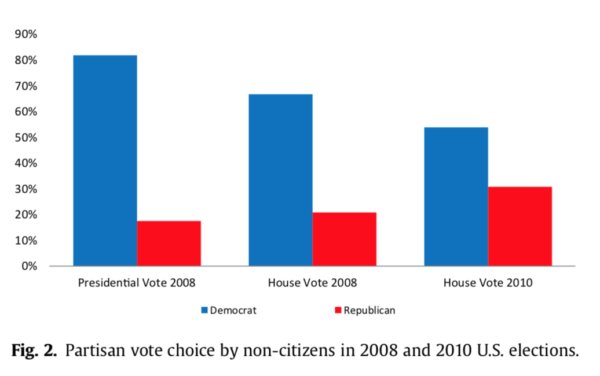Liberals and the media (but I repeat . . .) dismiss the idea that non-citizens vote in meaningful numbers in our elections. What is the empirical evidence? This 2014 article from Electoral Studies ought to be a wake-up call:
Do non-citizens vote in U.S. elections?
Jesse T. Richman, Gulshan A. Chattha, and David C.Earnest
Abstract
In spite of substantial public controversy, very little reliable data exists concerning the frequency with which non-citizen immigrants participate in United States elections. Although such participation is a violation of election laws in most parts of the United States, enforcement depends principally on disclosure of citizenship status at the time of voter registration. This study examines participation rates by non-citizens using a nationally representative sample that includes non-citizen immigrants. We find that some non-citizens participate in U.S. elections, and that this participation has been large enough to change meaningful election outcomes including Electoral College votes, and Congressional elections. Non-citizen votes likely gave Senate Democrats the pivotal 60th vote needed to overcome filibusters in order to pass health care reform and other Obama administration priorities in the 111th Congress.
The full article is behind the usual paywall, but I have managed to get the whole thing. And surprise, surprise, the authors conclude that illegal votes by non-citizens heavily favor Democrats, as this chart from the study shows:

Based on survey samples of 32,000 voters in 2008 and 55,000 voters in 2010, the authors among other things find:
• It is likely though by no means certain that John McCain would have won North Carolina were it not for the votes for Obama cast by non-citizens.
• A similar analysis reveals that there was one House race and one Senate race during the 2008 and 2010 election cycles which were close enough for votes by non-citizens to potentially account for the entirety of the Democratic victor’s margin. As before this analysis merges Census estimates of the number of adult non-citizens by House district and State with FEC tabulations of final election results. In 2008 there were 22 House races and two Senate races in which the Democratic candidate’s winning margin was small enough that less than 100 percent turnout among non-citizens could account for Democratic victory, and in 2010 there were 24 such House districts and three Senate races.
• The MN 2008 Senate race is also the race where the smallest portion of non-citizen votes would have tipped the balance—participation by more than 0.65% of non-citizens in MN is sufficient to account for the entirety of Franken’s margin. Our best guess is that nearly ten times as many voted.
One interesting additional conclusion is that voter ID laws might not make that much difference:
Our results also suggest that photo-identification requirements are unlikely to be effective at preventing electoral participation by non-citizen immigrants: In 2008, more than two thirds of non-citizen immigrants who indicated that they were asked to show photo- identification reported that they went on to cast a vote.
The study estimates that as much as 15 percent of non-citizens living in the U.S. voted in 2008, but only 3 percent in 2010. I wonder what the numbers look like this year, especially in Arizona, Florida, and Georgia. We have work to do.
Notice: All comments are subject to moderation. Our comments are intended to be a forum for civil discourse bearing on the subject under discussion. Commenters who stray beyond the bounds of civility or employ what we deem gratuitous vulgarity in a comment — including, but not limited to, “s***,” “f***,” “a*******,” or one of their many variants — will be banned without further notice in the sole discretion of the site moderator.